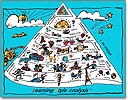When your child enters a primary school classroom, they will most likely be greeted by a row of computers by the wall. These are predominantly used before school and during rainy lunch breaks to play educational games, although the teacher may include a lesson on Google searches for older children. The library may have iPads with graphic novels and interactive texts. Still, most learning takes place the old-fashioned way: number games, plays from the School Journal, exploring the orchard in search of inspiration for poems and pitching real tents during Outdoor Education Week.
At intermediate school and college, though, computers become essential learning tools. Most teachers love tablet computers because they make textbooks come alive. Education simply is more interactive and fun with electronic gadgets. Computers encourage a natural form of discovery through trial and error. They can tutor those who are falling behind, repeating the lesson as many times as an individual learner needs it. E-simulations empower students to experiment with and experience a variety of complex systems such as weather patterns, mechanics, business models, and political phenomena. Working together on projects that involve computers fosters collaboration among students, as well as between students and teachers.
So is computer technology in the classroom a giant step for mankind? “There is very little evidence that kids learn more, faster or better by using these machines,” says Larry Cuban, a professor emeritus of education at Stanford University. He believes the money would be better spent on recruiting, training and retaining teachers, who still form the essence of education. “IPads are marvellous tools to engage kids, but then the novelty wears off and you get into hard-core issues of teaching and learning.”
The absence of real human interaction, such as facial expression, body language, and tone of voice cues, make education software a very poor teacher of everyday social interactions.
The lack of physical interaction with the real world is also an issue, and we’re not only talking sedentary life style. If a child has only experienced something on the computer, like driving a car or playing golf, they won’t know what the real thing feels like. The simulation will not mean anything to them and won’t prepare them for real life. The weightless tenpin bowling on the Wii is misleading compared to the real heavy ball, so a Wii bowling champ may be lost in a bowling alley.
Some children learn better with the aid of a computer than others. It all depends on their learning style preferences. What is your child's learning style?
Computers are an integral part of the civilisation in which our children are growing up. If we want them to keep up with the fast-paced world of technology, then we need to accept that some of their learning will have to come via a computer screen. Just as long as a good portion of learning continues to come from real trips to the zoo, mixing real paints, and smelling real roses, the computer can be a superb learning tool.


No comments:
Post a Comment